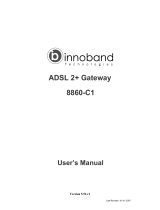
Billion BiPAC 7402NX(L) 802.11n 3G/ADSL2+ (VPN) Firewall Router
Table of Contents
WPS................................................................................................................................47
Port Setting .....................................................................................................................59
DHCP Server ..................................................................................................................60
WAN - Wide Area Network .................................................................................................61
WAN Interface.................................................................................................................61
WAN Profile.....................................................................................................................63
ADSL Mode.....................................................................................................................80
System................................................................................................................................81
Time Zone .......................................................................................................................81
Remote Access ...............................................................................................................82
Firmware Upgrade ..........................................................................................................82
Backup / Restore.............................................................................................................83
Restart Router.................................................................................................................84
User Management...........................................................................................................85
Mail Alert .........................................................................................................................87
Firewall and Access Control ...............................................................................................88
General Settings .............................................................................................................89
Packet Filter ....................................................................................................................90
Intrusion Detection
..........................................................................................................97
URL Filter
........................................................................................................................99
IM / P2P Blocking..........................................................................................................102
Firewall Log...................................................................................................................103
VPN - Virtual Private Networks (BiPAC 7402NX only)......................................................104
PPTP (Point-to-Point Tunneling Protocol) .....................................................................104
IPSec (IP Security Protocol).......................................................................................... 112
L2TP (Layer Two Tunneling Protocol) ...........................................................................121
QoS - Quality of Service...................................................................................................133
Prioritization ..................................................................................................................133
Outbound IP Throttling (LAN to WAN)...........................................................................135
Inbound IP Throttling (WAN to LAN) .............................................................................136
Virtual Server (known as Port Forwarding).......................................................................142
Add Virtual Server .........................................................................................................143
Edit DMZ Host...............................................................................................................144
Edit DMZ Host
...............................................................................................................145
Edit One-to-One NAT (Network Address T
ranslation) ...................................................146
Wake on LAN....................................................................................................................149
Time Schedule..................................................................................................................150
Configuration of Time Schedule ....................................................................................151
Advanced..........................................................................................................................152
Static Route...................................................................................................................152
Static ARP .....................................................................................................................152
Dynamic DNS................................................................................................................153
Device Management .....................................................................................................154
IGMP.............................................................................................................................158
MLD ..............................................................................................................................158
VLAN Bridge
.................................................................................................................159
Logout ..................................................................................................................................159
Chapter 5: Troubleshooting
......................................................................................................160
Problems starting up the router ............................................................................................160
Problems with the WAN Interface.........................................................................................160
Problems with the LAN Interface
..........................................................................................160




















